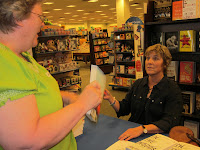 Lynda Rutledge, creator and author of Faith Bass Darling's
Last Garage Sale, gave us a double gift this month: a delightful book and a
lively and interesting visit! The story had well-developed characters, plot
twists, and life issues, all served with a side of humor. Some of the issues
were profound and some of the characters' suffering involved serious aspects
of life, but the humor kept the story of aging and Alzheimer's disease moving
forward rather than moving into a vale of tears. Even if some of us may have
experienced some sadness while reading about Faith Bass Darling, we were left at
the end with just the right combination of understanding, completion, and a few
purposefully loose ends implying hope.
Lynda Rutledge, creator and author of Faith Bass Darling's
Last Garage Sale, gave us a double gift this month: a delightful book and a
lively and interesting visit! The story had well-developed characters, plot
twists, and life issues, all served with a side of humor. Some of the issues
were profound and some of the characters' suffering involved serious aspects
of life, but the humor kept the story of aging and Alzheimer's disease moving
forward rather than moving into a vale of tears. Even if some of us may have
experienced some sadness while reading about Faith Bass Darling, we were left at
the end with just the right combination of understanding, completion, and a few
purposefully loose ends implying hope.  |
| Add caption |
By sharing some of her artistic process with us, Rutledge
demonstrated that she did more than just write the story: she created it. As I
understood Rutledge to say, two events seemed to launch the story idea.
Rutledge grew up in a small town, where her father owned the "corner
drugstore." One of the perks from the store was that Rutledge collected
Superman comics from the start of the series. The first significant event was
that Rutledge's mother recently sold all the comics at a garage sale, at garage-sale
prices. The second was that Rutledge learned that the first Superman comic might have been worth a million dollars! These events plus some episodes of "Antiques
Roadshow" led Rutledge to think about what she calls
"provenance," ie, the history of an item and how it got from its
creation to where it is many years later. This combination of events and ideas inspired Rutledge's story line.
After telling us the history of the book and some of the
back story about some of the characters, Rutledge offered
to answer our questions. Rutledge had a refreshing attitude toward our
questions, noting which questions have been asked at other talks she has been
giving in the flurry of activity and publicity surrounding her novel. She
shared her decisions to leave some aspects of the book open-ended, such as the
reasons for Faith's not opening Claudia's letters but leaving them in an
accessible drawer. Did this imply that Alzheimer's had begun a long time ago
and/or that depression had a role to play in the onset of the dementia? We
don't need the answer to enjoy pondering the question. Rutledge also shared
that she originally wanted to leave the mystery of the ring unsolved but that
her publisher had guided against this much open-endedness. Lynda accepted the
publisher's advice, and I think most of us were glad she did!
 A write-up does not do this author visit justice, just as
the photos don't quite capture the animated Lynda Rutledge's outbursts of
mirth. Even though I took a lot of photos, I got very few of Lynda in focus
until we all got behind her and posed! We had a lot of fun with Rutledge and
wish her well with this and her next book!
A write-up does not do this author visit justice, just as
the photos don't quite capture the animated Lynda Rutledge's outbursts of
mirth. Even though I took a lot of photos, I got very few of Lynda in focus
until we all got behind her and posed! We had a lot of fun with Rutledge and
wish her well with this and her next book!


No comments:
Post a Comment